Imagine standing atop a structure that represents both tradition and modernity—Tokyo Tower. It’s not just another city landmark but a gateway to stunning views and vibrant cultural experiences. With its iconic orange and white stripes, it towers over the skyline, offering you a unique glimpse of Mount Fuji on clear days. But there’s more to uncover beneath its steel facade, where attractions and surprises await your discovery. What secrets does Tokyo Tower hold for you?
Key Takeaways
- Tokyo Tower, completed in 1958, stands at 333 meters and is a notable feature of Tokyo’s skyline.
- It offers two observation decks with panoramic city views, including glimpses of Mount Fuji on clear days.
- FootTown at the base offers a diverse range of attractions, including an aquarium, restaurants, and a rooftop amusement park.
- The tower transitioned to digital broadcasting in 2011, with Tokyo Skytree now the main hub.
- Easily accessible from Hamamatsucho Station, with nearby accommodations and dining options for visitors.
Construction and Design
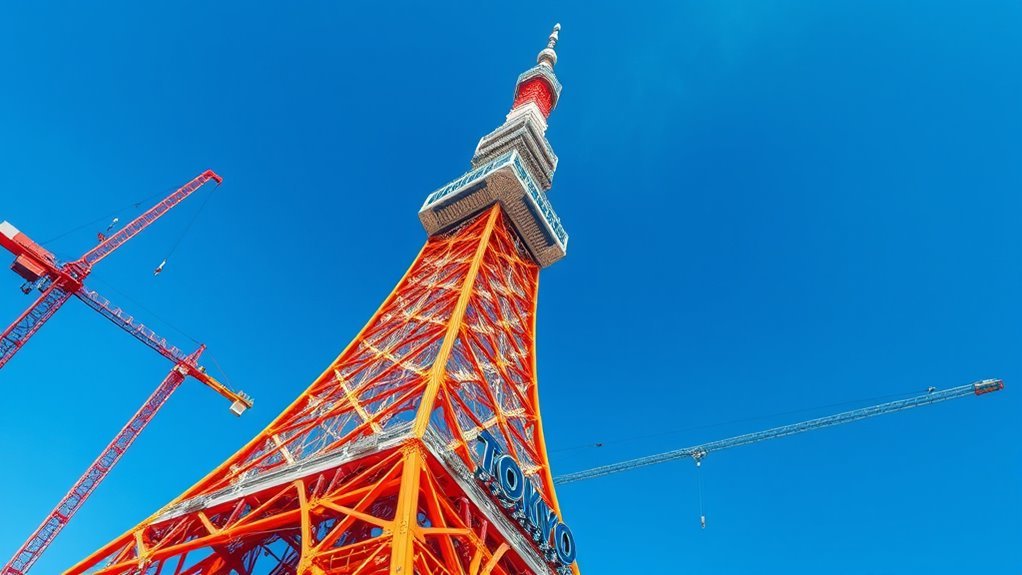
Although inspired by the Eiffel Tower, Tokyo Tower stands as a unique marvel in its own right since its completion in 1958.
You’ll find it fascinating that this steel tower rises to a height of 333 meters, making a bold statement in the Tokyo skyline. Its construction was a feat of ingenuity, employing about 400 laborers daily, and creatively utilizing one-third of the steel sourced from scrap metal of U.S. tanks.
The final cost reached ¥2.8 billion, a substantial investment at the time. Its design, featuring orange and white stripes, isn’t just for aesthetics; it adheres to air safety regulations.
Tokyo Tower remained Japan’s tallest structure until 2012, proudly showcasing the blend of function and form in its design.
Observation Decks
When visiting Tokyo Tower, you can enjoy breathtaking city views from its two main observation decks.
You have the option to take a high-speed elevator or tackle the 600-step staircase to reach the Main Observatory.
For an even more awe-inspiring experience, the Top Deck Tour offers access to the Special Observatory, where Tokyo’s skyline unfolds in all its glory.
Breathtaking City Views
Ever wondered what it’s like to see Tokyo from above? At Tokyo Tower’s Main Deck, 150 meters high, you’ll experience breathtaking city views like no other.
The panoramic views from this vantage point offer a mesmerizing glimpse of the sprawling metropolis. With glass skywalk windows, you can look directly down, feeling the thrill of being suspended over the city.
Take it up a notch at the Special Observatory, perched 249.6 meters above ground. Here, 360° views reveal Tokyo’s vastness, and on clear days, the majestic Mount Fuji stands out against the horizon.
As the sun sets, the city transforms into a sea of twinkling lights, creating an enchanting spectacle. Tokyo Tower’s observation decks offer an unforgettable visual feast, enthralling both day and night.
Elevator and Stair Access
You have two exciting ways to access Tokyo Tower’s Main Deck: a high-speed elevator or a 600-step outdoor staircase.
If you opt for the elevator, you’ll enjoy a swift ascent in glass-sided cabins that offer stunning views of the city and a unique perspective of the tower’s structure as you rise to 150 meters (490 feet). The elevator ride is part of the experience and included in the admission fee, making it a convenient choice.
For a more adventurous approach, tackle the outdoor staircase, giving you a rewarding physical challenge and different city views.
Once at the Main Deck, you can decide to continue your journey on the Top Deck Tour, where you’ll reach an impressive height of 250 meters (820 feet).
Visitor Attractions and Foot Town
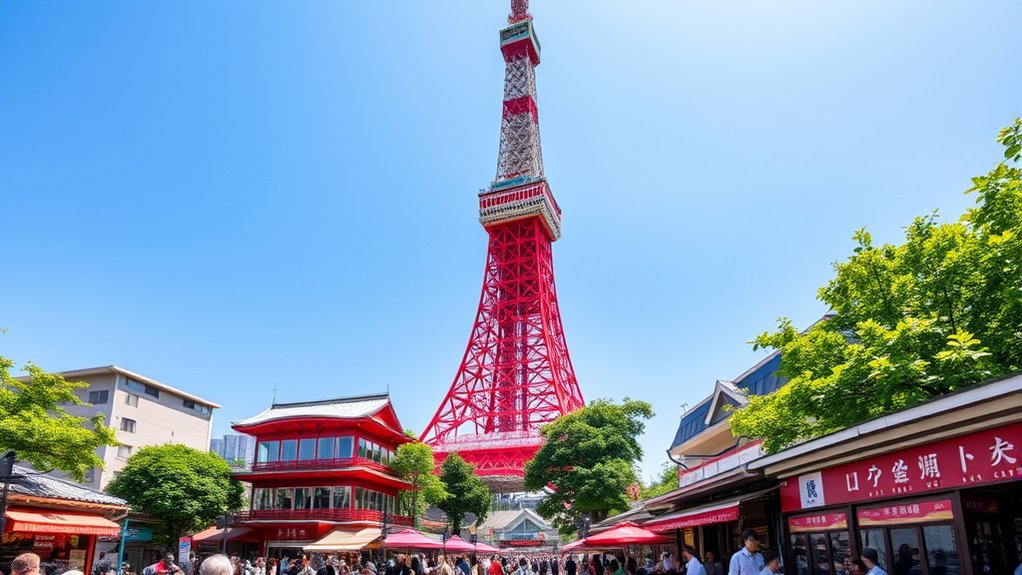
FootTown, nestled at the base of Tokyo Tower, offers a vibrant mix of attractions that cater to all ages.
As you explore, take in the aquarium gallery and savor the city view from the observation decks. Immerse yourself in a diverse range of visitor attractions, including a 400-capacity restaurant with panoramic city views.
On the first floor, you’ll find dining options and an aquarium, while the second floor features a bustling food court with favorites like McDonald’s and Pizza-La.
Discover the Guinness World Records Museum on the third floor, and marvel at optical illusions in the Trick Art Gallery on the fourth.
Don’t forget the small rooftop amusement park, perfect for families. FootTown guarantees everyone leaves with unforgettable memories and perhaps a souvenir or two.
Broadcasting and Digital Transition
Although it began as a broadcasting facility in 1961, Tokyo Tower’s role in Japan’s communication landscape has evolved considerably.
The shift to digital broadcasting in July 2011 marked a significant milestone, aligning with the national transition from analog to digital signals. However, the iconic structure couldn’t keep up with modern demands, which led to the debut of Tokyo Skytree in 2012. This new tower became the primary hub for digital broadcasting, leaving Tokyo Tower with limited operations.
- Antenna Damage: The 2011 Tōhoku earthquake damaged the tower’s antenna, necessitating repairs.
- Current Use: FM radio stations, such as Tokyo FM and InterFM, continue to broadcast from the tower.
- Digital Holdout: Only the Open University of Japan broadcasts digital TV from here.
- Historical Significance: Remains an integral part of Japan’s broadcasting history.
Media Representation and Pop Culture
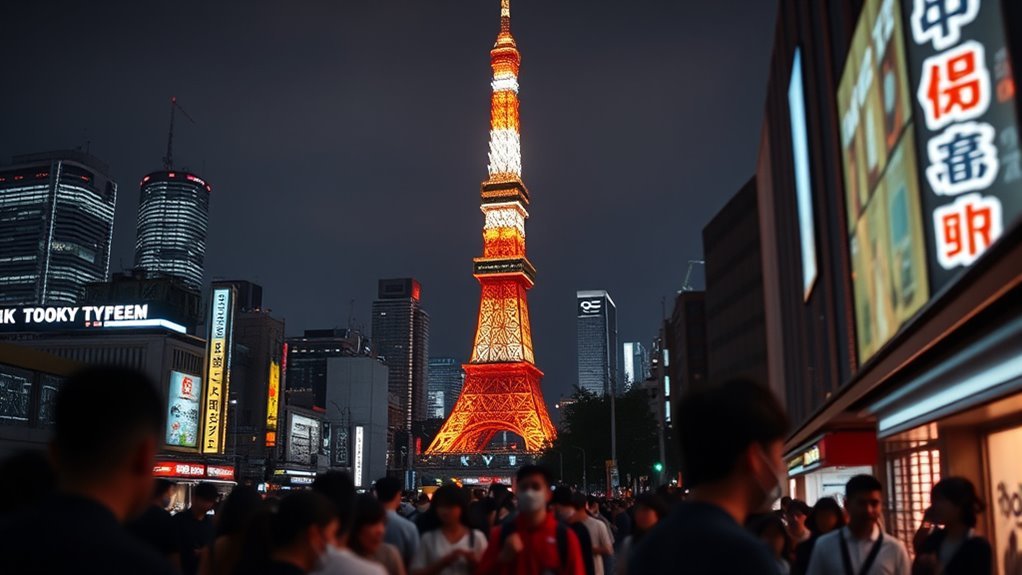
As a towering symbol of Tokyo’s skyline, Tokyo Tower frequently appears on screens in pop culture, leaving an indelible mark on anime and manga series such as “Doraemon,” “Cardcaptor Sakura,” and “Death Note.”
Its allure extends to kaiju films, where it often meets its cinematic demise, underscoring its iconic status. You see it not only as a backdrop in these vibrant narratives but also as a cultural symbol captured in the 🗼 emoji.
The tower represents Japan’s post-war economic resurgence, a beacon of financial prosperity in nostalgic Shōwa era fiction. Since 1961, I have served as a key broadcasting facility, further solidifying its presence in Japanese media.
Whether in stories of fantasy or history, Tokyo Tower remains a steadfast cultural icon.
Maintenance and Renovation
Whenever you gaze at Tokyo Tower, you mightn’t realize the meticulous care and maintenance it requires to stand tall and vibrant.
Every five years, the tower undergoes a year-long maintenance process, using about 28,000 liters of paint to meet air safety regulations. Renovations are essential, as evidenced by the suspension of Top Deck operations in 2016, which reopened on March 3, 2018.
During maintenance, the main deck faced partial closures starting in September 2016. The 2011 Tōhoku earthquake temporarily reduced the tower’s height to 315 meters due to antenna repairs.
- Fun Fact: The Tokyo Tower weighs approximately 4,000 tons, which is lighter than the Eiffel Tower.
- Did You Know? Regular maintenance keeps the vibrant red and white colors intact.
- Current Height: 333 meters.
- Operational Since: 1958.
Getting There and Accessibility

You’ll find Tokyo Tower is easily accessible, thanks to its proximity to various subway stations, such as Onarimon and Kamiyacho, both just a short 5-10 minute walk away.
If you’re coming from Hamamatsucho Station on the JR Yamanote Line, it’s only a 15-20 minute stroll.
For even more convenience, you can also use Daimon Station on the Asakusa or Oedo lines, making your journey to this iconic landmark smooth and straightforward.
Convenient Public Transit Options
Traveling to Tokyo Tower is a breeze thanks to its excellent connectivity with public transit. You can easily reach the tower via several convenient subway stations.
Onarimon Station is a popular choice, offering quick access. For those using the JR Yamanote Line, a pleasant 15-20 minute walk from Hamamatsucho Station will take you there.
The Oedo Subway Line provides direct access to Akabanebashi Station, just a short distance away.
Here are some helpful tips for your journey:
- Onarimon Station: Quick access to the tower.
- JR Yamanote Line: A scenic walk from Hamamatsucho Station.
- Oedo Subway Line: Direct route to Akabanebashi Station.
- Detailed Maps: Available for easy navigation.
With these convenient options, visiting Tokyo Tower is simple and stress-free.
Walking Distance Stations Nearby
There are three subway stations within a short 5 to 10-minute walk from Tokyo Tower, making it easily accessible for visitors.
Onarimon Station, Akabanebashi Station, and Kamiyacho Station all offer convenient access to the iconic landmark. If you’re using the Oedo Subway Line, you’ll find Akabanebashi Station especially handy for your visit.
Walking distance from these subway stations guarantees you can reach Tokyo Tower with ease, whether you’re exploring the city or just taking in the sights.
Additionally, detailed maps are available to help navigate your way, simplifying travel plans. Proximity to these major transport routes allows you to enjoy a seamless journey from various parts of Tokyo, enhancing your overall experience at Tokyo Tower.
Access via JR Yamanote Line
While Tokyo Tower is easily accessible from nearby subway stations, the JR Yamanote Line offers another convenient route for your visit.
Hamamatsucho Station, the closest JR station to Tokyo Tower, is a mere 15-20 minute walk away. This provides easy access, especially if you’re traveling by train.
The Yamanote Line, with its loop around central Tokyo, makes Hamamatsucho Station a strategic point for tourists. Clear signs from the station guide you directly to the tower, so even if you’re unfamiliar with the area, finding your way is simple.
Here are some quick tips to enhance your journey:
- Start from any Yamanote Line station for direct access.
- Follow the signs at Hamamatsucho Station.
- Enjoy a scenic walk to Tokyo Tower.
- Combine with other nearby attractions.
Nearby Accommodations and Dining
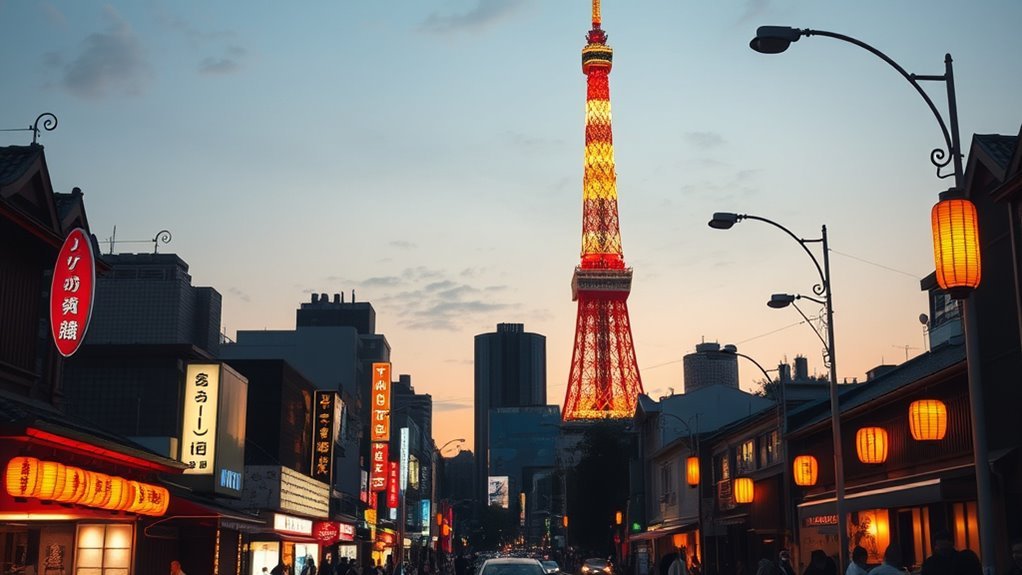
Exploring the area around Tokyo Tower, you’ll find a range of accommodations and dining options to suit every taste and budget.
For budget-friendly stays, consider Mokkoan, which offers free WiFi and a hot tub, or Hanare in Taito, featuring shared facilities.
If you’re seeking mid-range comfort, SOLA HOTEL and Tokyo Inn Sakura offer family rooms and free bikes, ideal for exploring the vicinity of Tokyo Tower.
For a traditional Japanese experience, Cyashitsu Ryokan Asakusa invites you to enjoy open-air baths and authentic cuisine.
When it comes to dining, Tokyo Shiba Tofuya Ukai delights with traditional dishes, while Niigata Yukimuro Jukusei Yakiniku Nikuine Roppongi offers barbecue flavors.
With numerous restaurants within a 3-mile radius, you’ll never run out of culinary adventures.
Ticketing and Pricing Information
When planning your visit to Tokyo Tower, understanding the ticketing and pricing information is essential. Admission to the Main Deck costs approximately 1,500 yen, while the Top Deck Tour is priced at 3,500 yen if purchased at the ticket counter or 3,300 yen online.
It’s wise to book tickets in advance to skip long queues. You can also find group reservations and family packages on platforms like Klook, which might offer some savings. Please note that additional charges apply for photographs on the second level, priced at 1,500 yen.
Here are some quick tips for your visit:
- Purchase tickets online to save money and time.
- Check for group discounts if visiting with friends or family.
- Plan for the Top Deck Tour for stunning views.
- Consider photography costs when budgeting.
Visitor Insights and Best Times to Visit
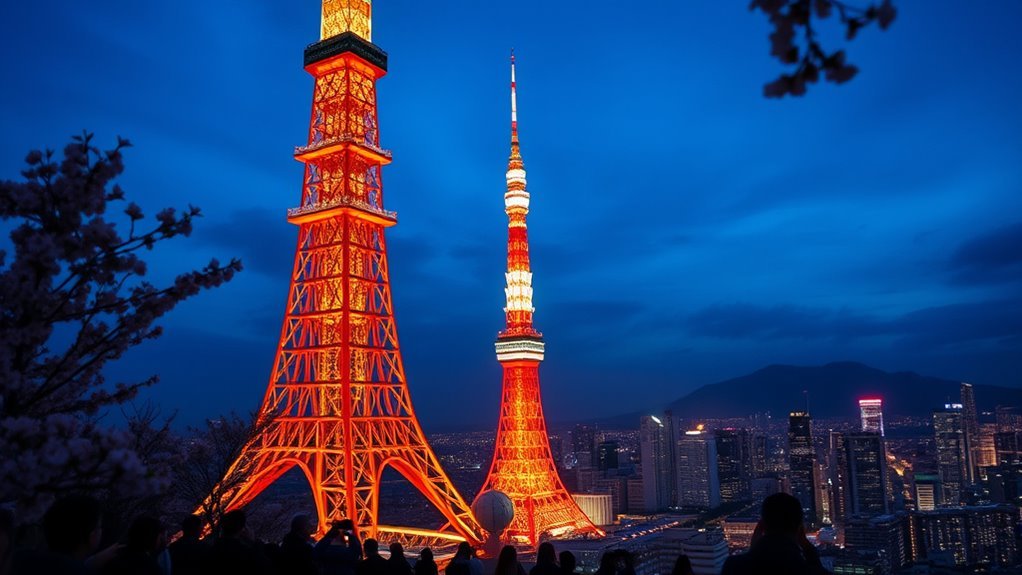
How can you make the most of your visit to Tokyo Tower? Start by planning your visit during the early evening. This timing treats you to stunning sunset views and the mesmerizing illumination of city lights.
The observation decks, perched at 150 meters and 250 meters, offer breathtaking views of the city and even Mount Fuji on clear days. For a unique perspective, don’t miss the Main Deck’s glass floor section, where panoramic views unfold beneath your feet.
To avoid long lines, steer clear of local holidays. A typical visit lasts over three hours, so allocate ample time to enjoy both day and night views. Towers like Tokyo Tower truly shine when you see them at their brightest moments.
Conclusion
When you visit Tokyo Tower, you’ll be captivated by its iconic design and breathtaking views. Don’t miss the chance to explore the observation decks for a glimpse of Mount Fuji or investigate FootTown’s attractions. The tower stands as a beacon of both entertainment and history in Tokyo’s skyline. With convenient access, nearby dining, and accommodations, your visit will be seamless. Plan your trip wisely for the best experience, and let Tokyo Tower’s charm leave a lasting impression.
FAQs
1. Why Is the Tokyo Tower so Famous?
You find it enchanting because its design draws inspiration from a famous landmark and serves multiple purposes. Its cultural appearances and stunning illuminations enchant millions, making it an iconic and beloved symbol recognized worldwide.
2. Is the Tokyo Tower Worth Visiting?
You’re wondering if it’s worth visiting. You won’t regret it! You’ll enjoy breathtaking views, rich cultural history, and a diverse array of attractions. Don’t miss out on immersive experiences and exclusive discounts by booking online. Allocate three hours for maximum enjoyment.
3. Is Tokyo Skytree the Same as Tokyo Tower?
You might think Tokyo Skytree and Tokyo Tower are the same, but they’re not. Skytree is taller, newer, and built for digital broadcasting, while Tokyo Tower has been an iconic landmark since 1958, serving primarily as a broadcast tower for FM radio now.
4. How Much Does It Cost to Visit Tokyo Tower?
You’ll spend about 1,500 yen per person for the Main Deck. For the Top Deck Tour, the price is 3,500 yen at the counter or 3,300 yen online. Check online for discounts before you make your purchase.

